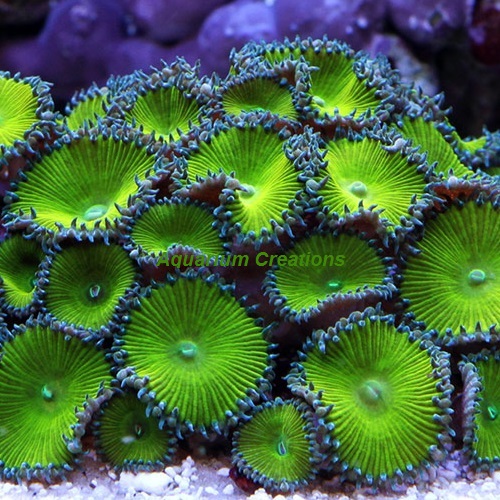Nuclear Green Palythoas (or “Palys”) are one of the most visually interesting soft corals around. Nuclear Green Paly's are also called Green Sun Palythoa. Vibrant hues of green and aqua radiate from the mouth of each polyp out toward the neon green lashes. These paly’s can be added to the bases of rockwork to create a stunning groundcover effect. It is an amazing Paly to add to your collection because of its size as well as its glowing coloration. With the polyps ranging in size up to 1.5 inches when fully grown and open, the coverage is amazing even with only a few polyps. Growth is at a moderate pace. All Palythoa Grandis' color and patterns will change drastically depending on the type of light they are living under. Nuclear Green palythoa are found at an average depth of 60-80 feet deep, therefore they are not heavily dependent on strong lighting but for maximum growth they are more dependent on meaty foods (such as a live copepod or two) and target feeding. As with any palythoa, these palys have the ability to secrete a nasty toxin referred to as palytoxin. When handling any palythoa polyps take precaution to use gloves and protect your eyes. They are easy to feed, and easy to propagate. Like all of our polyps they are aquacultured specimens, many generations removed from the original wild starter colonies.
Keeping your parameters at the standard level will help these corals stay happy. Set your salinity between 1.024 and 1.026. Your pH should range around 8.3 and your temperature should stay between 77 and 82 degrees Fahrenheit.
Aggressiveness
They are not an aggressive coral. They won't sting other corals.
Water flow
They do well in fast to slow water flow.
Lighting
Their color and pattern change depending on the amount of and type of light given. If a Par meter is available the appropriate lighting level is anywhere from a Par 50 all the way to a Par 150. For lighting spectrum use between a 14-20K color spectrum for your bulbs for best coloration.
Placement
Polyps may be placed anywhere which provides the required water flow and lighting level.
Diet and Feeding
Palythoas are the Venus Fly Trap of the sea. They happily accept mysis shrimp, tiny pcs. of squid, or any other chopped up meaty foods. They will also accept smaller foods like plankton. The more you feed them the faster they will grow. How do they know they are being fed? They contain a nerve net that senses vibration and things that come into contact with them. This often triggers them to close up as a defense mechanism or for consuming prey.
At night time Palythoa corals are usually closed unless you have a bright moonlight on or even if the room light is on. Any trace of light can keep them open all night. This may cause them to be stressed, but that is unlikely. The hardiness and growth rate of these corals make great propagators. You can take a frag of 8 polyps and turn it into 8 frags of 3 polyps within a couple months, thus making more than your money back.
Caution
One of the most fascinating aspects of the Palythoa is also one of the most deadly. Palythoas secrete a poison through their mucus known as palytoxin. Palytoxin is extremely dangerous, and it affects humans in a very adverse way. What this toxin does is mess with the cells of the heart, destroying their ion regulatory systems. The toxin enters the system via open wounds, ingestion, and injection. If there is no open wound, the skin becomes very irritated. Because of the lack of treatment, what is highly recommended with these creatures is to wear protective gear, such as gloves and goggles, and to use tongs which will help distance the creature from any contact with the skin.
|



